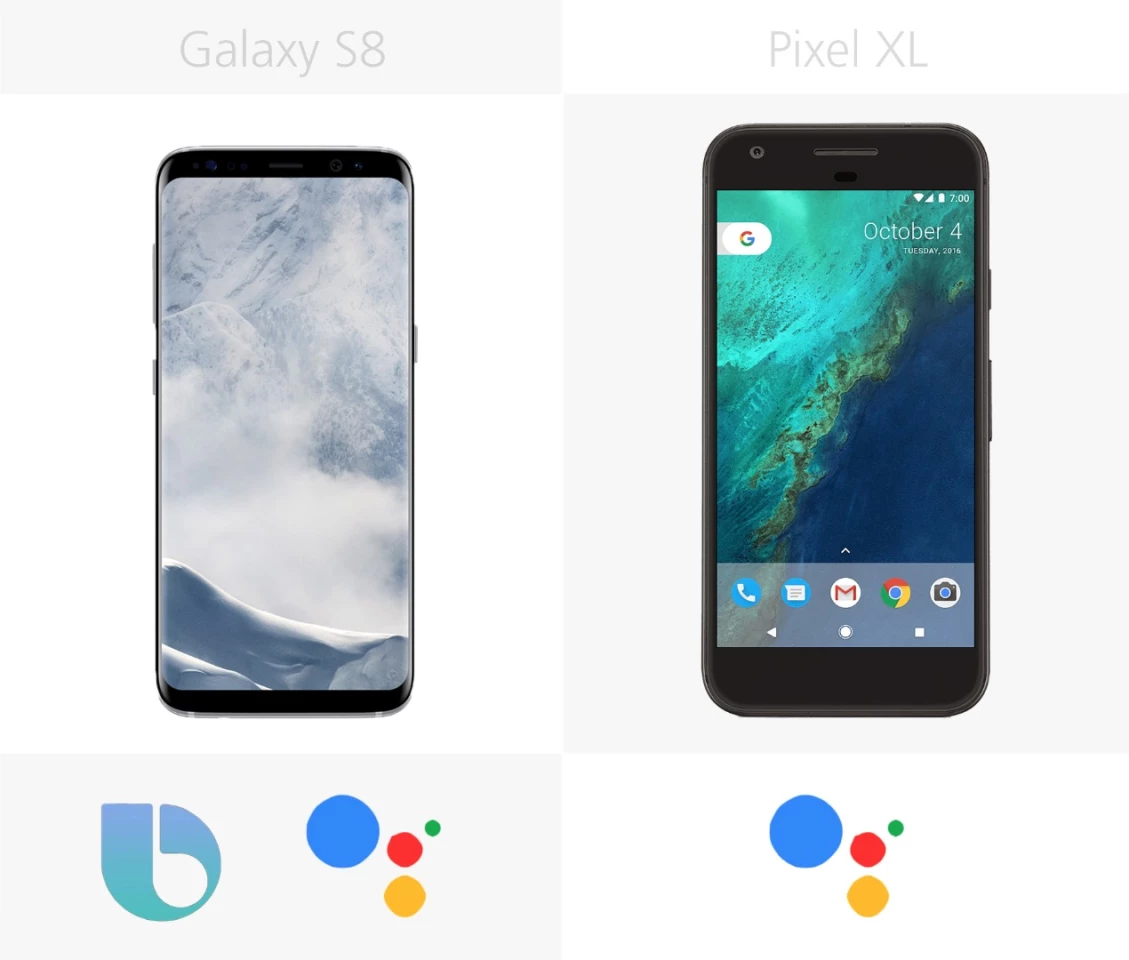You might expect Samsung's bigger Galaxy S8+ to be the more natural rival to Google's Pixel XL (the bigger of its pair), but in many ways the standard S8 makes more sense next to Google's phablet. Read on, as we compare the features and specs of the Galaxy S8 and Pixel XL.
Size

The Pixel XL lives up to its name, coming out 4-percent taller and 12-percent wider than the Galaxy S8.
Weight

The Pixel XL is also 8-percent heavier.
Build

Both phones' constructions use a combination of aluminum and glass, though their prominence is flipped. The S8 has a glass back (and, of course, front) along with a minimal aluminum frame. The Pixel, meanwhile, has a mostly aluminum body with a small glass panel up by the rear camera.
Water resistance

The Pixel XL doesn't have any significant water resistance, but the Galaxy S8 does, with its IP68 rating.
Colors

You have five color options for the S8 and three for the Pixel.
Display size

If you ignore misleading diagonal measurements and focus instead on area, screen sizes are very similar: The S8's comes out 2-percent bigger.
When you consider, though, how much smaller a phone the Galaxy S8 is, you see it delivers a much more economical balance of screen size to phone size, with that nearly bezel-free "Infinity Screen."
Display resolution

Both phones have ultra-sharp displays, but we give the nod to the Galaxy S8. So does the most prominent mobile-screen expert.
Display type

Both use AMOLED tech.
Curved display

Similar to (but not quite as pronounced as) Samsung's Edge series phones, the S8's screen slopes off on both sides.
Camera megapixels

You can't go wrong with either camera. We picked the Pixel's shooter as the best of 2016, and so far we're very impressed with the S8's as well. Both use multiple shots (taken in quick succession), spliced together with background algorithms to create one gorgeous pic.
Camera aperture (rear)

Both are also great in low-lit settings, though the S8 has the wider aperture.
OIS

The Pixel's photography algorithms make its lack of Optical Image Stabilization a non-starter, but the S8, despite using a similar approach to photo processing, throws OIS in for good measure.
Battery

The Pixel XL has the bigger battery, but so far the S8 series isn't showing us any problems in regular use. Stay tuned for formal benchmarks in a full S8 review.
Fast charging

Like any modern high-end Android phone, both employ quick-charging tech.
Wireless charging

Only the S8, though, supports wireless charging (including fast wireless charging).
VR support

If you're eyeing mobile VR, these smartphones are two of your prime options.
The Galaxy S8 pairs with the Gear VR, which has the best selection of mobile virtual reality content. The Pixel XL is one of the few Android phones that works with Google's Daydream View headset.
Processor

The S8 has the newer/faster processor, but the Pixel's late-2017 Snapdragon 821 is still a beast.
RAM

Both phones have 4 GB of RAM.
Storage

Rather than offering multiple tiers, Samsung put a generous 64 GB internal storage in all versions of the S8.
microSD

The Galaxy S8 also has a microSD slot, to complement that internal storage.
Fingerprint sensor

Both phones' fingerprint scanners are on their backsides, but the Galaxy's is placed a bit more awkwardly, off to the right of the rear camera.
Iris scanner

Fortunately Samsung makes up for the strange fingerprint sensor placement with an iris scanner that's much faster and more reliable than the one in the ill-fated Note 7.
Virtual assistant

At the S8's launch event, we thought it was a little odd that Samsung included both its new Bixby assistant and Google Assistant on the same device. That made more sense, though, after it came to light that Bixby's voice control wasn't going to be activated at launch, rendering the service mildly useful at best until Samsung finishes its assistant.
Mobile payments

The S8 supports Samsung Pay and the Pixel runs Android Pay, so you can pay with your phone.
The big advantage for Samsung Pay is that it works at most swipe-based credit card readers, no NFC equipment required.
Headphone jack

Unlike Apple, both Samsung and Google left the headphone jack in their latest flagships.
PC dock

If you want to do something really wacky (and perhaps useful in a pinch) with your phone, Samsung sells an optional dock that attaches the phone to a monitor, mouse and keyboard to power a faux desktop PC experience.
Software

Both run Android Nougat, but Samsung's is skinned with the TouchWiz UI (which, in past generations, has sometimes slowed down performance over time) while the Pixel runs pure/stock Android.
Release

The S8 just launched this month.
Starting price (full retail)

Prices are very similar. Considering the newer Galaxy S8 has a bigger and better screen, faster processor, iris scanning and a sexier build, it's probably going to be the better choice at this stage. Android purists, however, may still appreciate the Pixel's no-frills/stock-Android approach, even seven months after launch.
For more, you can read New Atlas' early impressions of the S8's big sibling, and our review of the Pixel XL.


